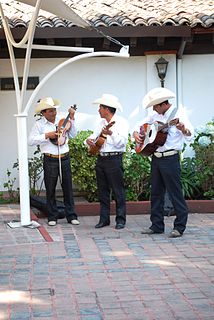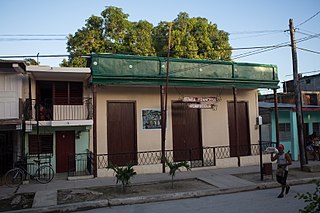 W
WBaile folklórico, literally "folkloric dance" in Spanish, also known as ballet folklórico, is a collective term for traditional Mexican dances that emphasize local folk culture with ballet characteristics – pointed toes, exaggerated movements, highly choreographed. As mentioned below, baile folklórico owes its inception to Amalia Hernández Navarro. Baile folklórico differs from danzas and regional bailes. "Folk dances", that is, "dances that you will find in the villages, not on stage" were researched and disseminated by Alura Angeles de Flores. A good rule of thumb is if the woman raises her hands about her head, it is folklórico. Each region in Mexico, the Southwestern United States and Central American countries is known for a handful of locally characteristic dances.
 W
WBallet Folklórico de México is a Mexican folkloric ensemble in Mexico City. For six decades it has presented dances in costumes that reflect the traditional culture of Mexico. The ensemble has appeared under the name Ballet Folklórico de México de Amalia Hernández.
 W
WCumbia [ˈkumbja] is a folkloric genre and dance from Colombia.
 W
WCumbia [ˈkumbja] is a musical genre and folk dance from Panama, inherited between Colombia and Panama as a single republic before their separation in 1903.
 W
WA deer dance is any of the world's folk dances performed by people dressed as deer.
 W
WFolk dance of Mexico, commonly known as baile folklorico or Mexican ballet folk dance, is a term used to collectively describe traditional Mexican folk dances. Ballet folklórico is not just one type of dance, it encompasses each region's traditional dance that has been influenced by their local folklore and has been entwined with ballet characteristics to be made into a theatrical production. Each dance represents a different region in Mexico illustrated through their different zapateado, footwork, having differing stomps or heel toe points, and choreography that imitates animals from their region such as horses, iguanas, and vultures.
 W
WHuapango is a family of Mexican music styles. The word likely derives from the Nahuatl word cuauhpanco that literally means 'on top of the wood', alluding to a wooden platform on which dancers perform zapateado dance steps. It is interpreted in different forms, the most common being the classic huapango interpreted by a trio of musicians ; the huapango norteño interpreted by a group ; and the huapango de mariachi, which can be performed by a large group of musicians.
 W
WHuayno is a genre of popular Andean music and dance. It is especially common in Peru, Bolivia and Chile, and is practiced by a variety of ethnic groups, especially the Quechua people. The history of Huayno dates back to colonial Peru as a combination of traditional rural folk music and popular urban dance music. High-pitched vocals are accompanied by a variety of instruments, including quena (flute), harp, siku (panpipe), accordion, saxophone, charango, lute, violin, guitar, and mandolin. Some elements of huayno originate in the music of the pre-Columbian Andes, especially on the territory of the former Inca Empire. Huayno utilizes a distinctive rhythm in which the first beat is stressed and followed by two short beats.
 W
WJarabe tapatío, often referred to as the Mexican hat dance, is the national dance of Mexico. It originated as a courtship dance in Guadalajara, Jalisco, during the 19th century, although its elements can be traced back to the Spanish zambra and jabber gitano, which were popular during the times of the viceroyalty. Female dancers traditionally wear a china poblana outfit, while the male dancers dress as charros.
 W
WThe joropo is a musical style resembling the fandango, and an accompanying dance. It originated in Venezuelan territory and is also present in the eastern Colombian plains. It has African, Native South American, and European influences. There are different joropo variants: tuyero, oriental, and llanero. It is a fundamental genre of Venezuelan música criolla. It is also the most popular "folk rhythm": the well-known song "Alma Llanera" is a joropo, considered the unofficial national anthem of Venezuela.
 W
WMarinera is a courtship dance that originated along the coastal regions of Peru. Marinera is a graceful and romantic couple's dance that uses handkerchiefs as props. The dance is a mix of Spanish contradanza and Andean zamacueca and is an elegant and stylized reenactment of a courtship, and it shows a blend of the different cultures of Peru. The dance itself has gained recognition throughout South America and is known as the most prominent traditional dance of Peru. The city of Trujillo has been recognized as the national birthplace of the marinera since 1986. The Marinera Festival, a cultural event dedicated to marinera held in Trujillo, has held annual competitions of the dance since 1960. In 2012, the Congress of Peru observed nationally October 7 as a commemorative day for the marinera.
 W
WMerengue is a style of Dominican music and dance. Partners hold each other in a closed position. The leader holds the follower's waist with the leader's right hand, while holding the follower's right hand with the leader's left hand at the follower's eye level. Partners bend their knees slightly left and right, thus making the hips move left and right. The hips of the leader and follower move in the same direction throughout the song. Partners may walk sideways or circle each other, in small steps. They can switch to an open position and do separate turns without letting go each other's hands or releasing one hand. During these turns they may twist their handhold into intricate pretzels. Other choreographies are possible.
 W
WMexican cumbia is a type of cumbia, a music which originated in Colombia but was reinvented and adapted in Mexico.
 W
WThe Paraguayan bottle dance is a traditional folk dance from Paraguay in which performers dance with glass bottles balanced on their heads.
 W
WTumba francesa is a secular Afro-Cuban genre of dance, song, and drumming that emerged in Oriente, Cuba. It was introduced by slaves from the French colony of Saint-Domingue whose owners resettled in Cuba's eastern regions following the slave rebellion during the 1790s. The genre flourished in the late 19th century with the establishment of sociedades de tumba francesa, of which only three survive.